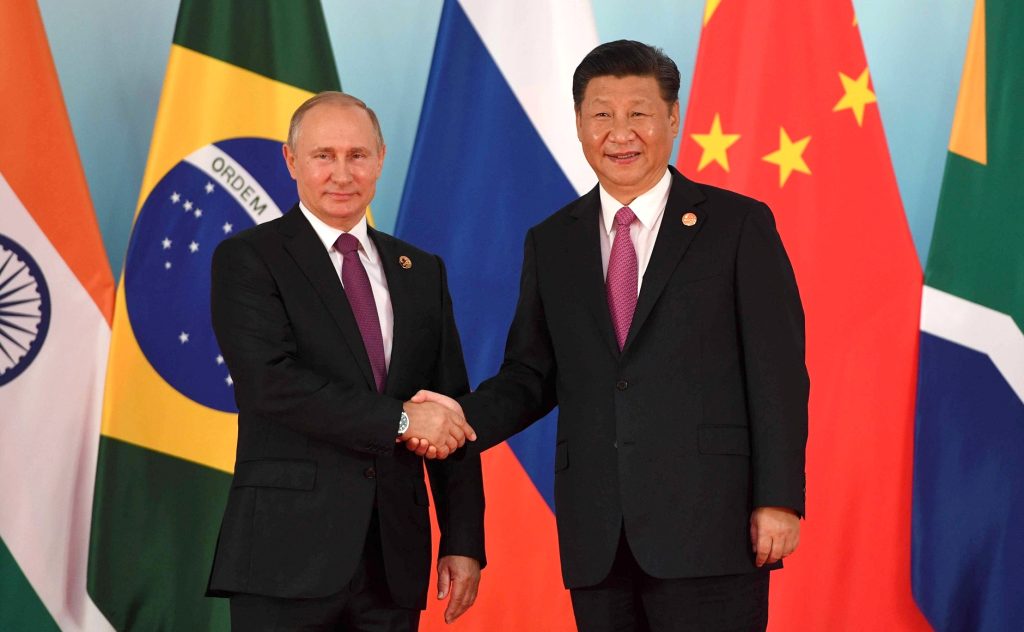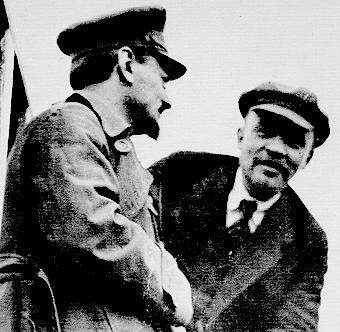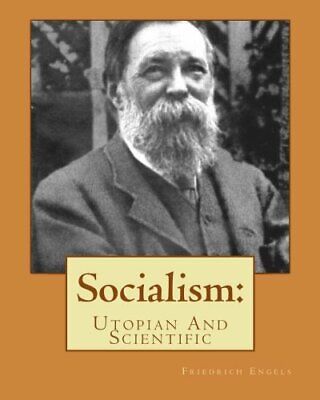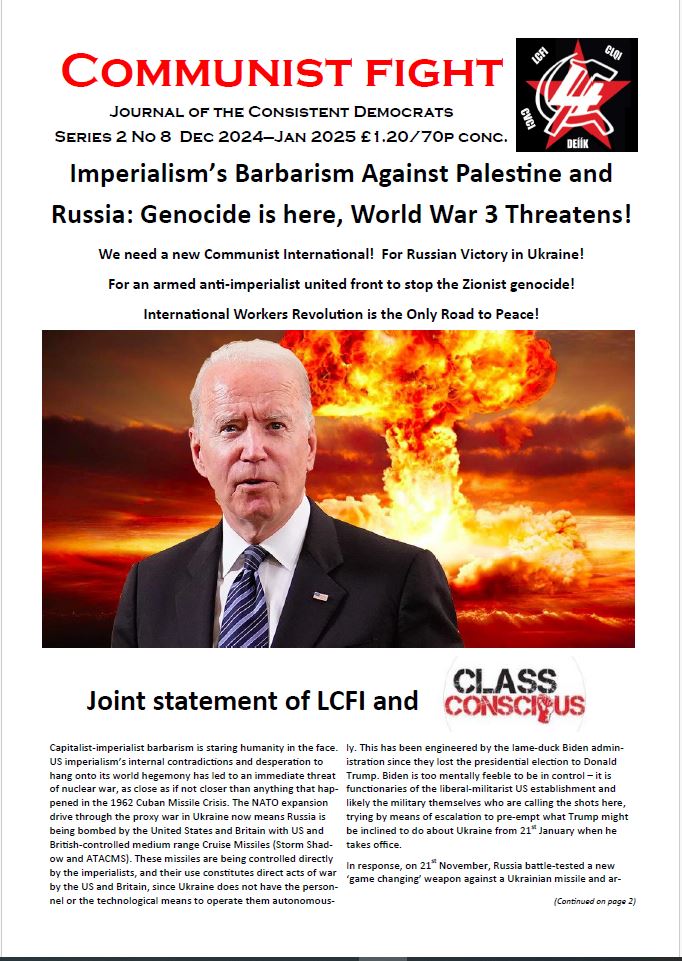
This presentation, by a Consistent Democrats speaker, and the discussion that followed it, is available as a podcast also.
This talk focuses on the nature of Russia and China today. It is based on the LCFI’s statement “Marxism and the Post-Counterrevolution Cold War” from just over a year ago. This is the beginning of the subject. We undoubtedly need more discussions to deal with the world situation today, and the road to world revolution. These are huge issues. We are living through a new historical period
The imperialist powers of European origin (with the sole exception of Japan), the monopoly capitalist powers that have enriched themselves and dominated the greater part of the globe, for approximately 150 years, have gone into the greatest crisis in their history. And what is remarkable is that this crisis is manifesting itself only 30 years or so after imperialist capitalism had achieved what seemed to be its greatest triumph. In 1991 the Soviet Union collapsed, and the former multinational degenerated workers state fragmented along national lines.
In Russia, its central component, a government came to power led by Boris Yeltsin, the former chief of the Moscow Communist Party, who had metamorphosed into first a populist demagogue, and then an advocate of the restoration of capitalist through a massive, rapid economic shock. The marketising regime of Mikhail Gorbachev, which whittled away at central planning in the name of perestroika (reconstruction) and which did away with the repression of the Stalinist regime in the name of glasnost (openness), acted a transitional ‘bridge’ to the rise of Yeltsin and the counterrevolution. This Yeltsin catastrophe happened less than two years after Gorbachev opened the Berlin wall, which resulted in the coming to power of capitalist restorationist regimes, liquidating the deformed workers states of Eastern Europe, with Poland under the pro-capitalist trade union, Solidarność, as the vanguard.
Parallel with this we had the rise of capitalism in China. Even though the Communist Party remained in power, since 1979 and the rise to power of Deng Xiaoping as leader of the party, a kind of pro-capitalist ideologue as well as being a ‘Communist’ bureaucrat. His regime broke the ‘iron rice bowl’, the system of collective welfare that was the foundation of the Chinese deformed workers state under Mao since the 1949 revolution. The watchword of Deng was ‘to get rich is glorious’: marketisation in China accelerated more quickly in China than in the USSR throughout the 1980s. Though the final breakthrough for capitalist restoration was controlled by the bureaucracy from above, not through a shock treatment directed at the bureaucracy externally, as in Russia. But through a massive intensification of marketisation/privatisation promoted by Deng on his Southern Tour in late 1992, which beat back the backlash within the bureaucracy against marketisation that occurred after Tien-An-Mien Square in 1989, and represented a qualitative turning point. So that is the initial background of the counterrevolutions in the main deformed workers states.
So, this educational is about the character of Russia and China today. Everyone above a certain age remembers the Cold War, most likely Cold War II, the warmongering crusade against Communism and the USSR led by Ronald Reagan. The hysterical, warmongering response to the Soviet intervention in Afghanistan in December 1979 is part of what won me to Trotskyism. The West provoked the Soviet intervention by funding and arming counterrevolutionary forces against a reforming government, the People’s Democratic Party of Afghanistan. The warmongering hysteria today over Russia’s SMO in Ukraine is certainly reminiscent of the Carter-Reagan warmongering over Afghanistan, as is their support of far-right extremist forces.
Similarly, what in the Ukraine, Georgia, or Hong Kong context are today called ‘colour revolutions’ – orchestrated and well-funded mass coup movements that are intended to overthrow governments – even elected ones – that the west disapproves of. These are somewhat familiar from the 1980s when the West funded counterrevolutionary movements in Eastern Europe – Polish Solidarność was the best-known example. A movement of workers, to be sure. But unlike the situation in the 1950s, when Hungarian and Polish workers rose up and demanded democratised workers states and workers control, in 1980 onwards Solidarność rapidly consolidated around a pro-capitalist, neoliberal programme. Such movements are familiar today, as are what they lead to.
What needs explaining is that capitalism, of a sort, is now dominant in the main former workers states, i.e. Russia, which does not claim to be socialist. And China, (whose Communist Party General Secretary Xi Jinping, is actually a dollar billionaire, with $1.2 billion according to Forbes). That is the legacy of the counterrevolutions of 1989-92. And yet the warmongering, crusade in Western countries against Russia and China is just as intense as it was in the Cold War of the 1980s, and for those old enough to remember, the Cold War of the 1950s also. Why is this?
It is because capitalist restoration has not proved as straightforward as the ideologues of Western imperialism made out in 1989, as exemplified by Francis Fukuyama and his essay “the End of History”. Marx’s vision was that human society would end its series of social transformations and revolutions, from primitive communism, which fell when humanity divided into classes, through slave- based production, then feudalism, through capitalism, to the final abolition of classes and the creation of developed communism. Fukuyama’s fatuous version had liberal imperialist capitalism in that role. A monstrous form of exploitation, not only of the working class in the advanced countries, but robbery of the bulk of humanity in the oppressed Global South, to extract the wealth that fuels the privileged position of the imperialist countries. Fukuyama’s vision was a complete insult to the bulk of humanity.
And to the population of the former USSR, particularly the population of Russia, who as part of this ‘end of history’ nonsense, were subject to a Pinochet-like neoliberal economic shock under Yeltsin that caused deaths by starvation, and suicide in the face of starvation, to Russian workers. This caused a fall in life expectancy of over 5 years in the early-mid 1990s, which can only be explained by millions of premature deaths. This resulted in a massive popular backlash from below. Which the Russian state responded to, giving rise to Putin’s who has become hated by imperialism because of his reversal of many of Yeltsin’ attacks. He is hated for this, not for ‘authoritarianism’. Similar things happened in China also, which also managed to make use of Western outsourcing to build itself industrially, using its state apparatus – derived from decades when it was a workers’ state. And has become the world’s industrial powerhouse.
We have been studying Leon Trotsky’s The Revolution Betrayed. We will not repeat here Trotsky’s analysis of the reasons for the rise of the bureaucratic caste in the USSR in in 1920s and 30s. Neither will we analyse the Chinese revolution of 1949, except to note that the workers state it created was not in the image of the early Soviet state of Lenin and Trotsky, literally a state of democratic workers councils, but rather one like Stalin’s USSR where the working class was deprived of power by kind of labour bureaucracy, right from the start. It was a sort of clone of Stalin’s USSR, not Lenin and Trotsky’s.

Trotsky foresaw that the bureaucratisation of the Soviet Union would lead to capitalist restoration. He was proved right, though not in his own lifetime. His warnings only came to pass decades after his death. Nevertheless, he was compelled to sketch out some basic features of such a counterrevolution. He wrote an important essay in 1937 titled: Not a workers’ and not a bourgeois state. I will quote some passages which shed light on what he considered likely:
“The proletariat of the USSR is the ruling class in a backward country where there is still a lack of the most vital necessities of life. The proletariat of the USSR rules in a land consisting of only one-twelfth part of humanity; imperialism rules over the remaining eleven-twelfths. The rule of the proletariat, already maimed by the backwardness and poverty of the country, is doubly and triply deformed under the pressure of world imperialism. The organ of the rule of the proletariat – the state – becomes an organ for pressure from imperialism (diplomacy, army, foreign trade, ideas, and customs). The struggle for domination, considered on a historical scale, is not between the proletariat and the bureaucracy, but between the proletariat and the world bourgeoisie… For the bourgeoisie – fascist as well as democratic – isolated counter-revolutionary exploits … do not suffice; it needs a complete counter-revolution in the relations of property and the opening of the Russian market. So long as this is not the case, the bourgeoisie considers the Soviet state hostile to it. And it is right.
“The internal regime in the colonial and semicolonial countries has a predominantly bourgeois character. But the pressure of foreign imperialism so alters and distorts the economic and political structure of these countries that the national bourgeoisie (even in the politically independent countries of South America) only partly reaches the height of a ruling class. The pressure of imperialism on backward countries does not, it is true, change their basic social character since the oppressor and oppressed represent only different levels of development in one and the same bourgeois society. Nevertheless the difference between England and India, Japan and China, the United States and Mexico is so big that we strictly differentiate between oppressor and oppressed bourgeois countries and we consider it our duty to support the latter against the former. The bourgeoisie of colonial and semi-colonial countries is a semi-ruling, semi-oppressed class.
“The pressure of imperialism on the Soviet Union has as its aim the alteration of the very nature of Soviet society… By this token the rule of the proletariat assumes an abridged, curbed, distorted character. One can with full justification say that the proletariat, ruling in one backward and isolated country, still remains an oppressed class. The source of oppression is world imperialism; the mechanism of transmission of the oppression – the bureaucracy. If in the words ‘a ruling and at the same time an oppressed class’ there is a contradiction, then it flows not from the mistakes of thought but from the contradiction in the very situation in the USSR. It is precisely because of this that we reject the theory of socialism in one country.”
This juxtaposition of the situation of the semi-colonial capitalist ruling classes, with that of the proletariat in power in a backward and isolated workers state, is highly suggestive of what Trotsky considered likely to happen in a counterrevolution. In a situation where the proletariat in power was oppressed by imperialist encirclement and backwardness, any bourgeois regime that were to replace it would face the same material conditions, and would likewise be a “semi-ruling, semi-oppressed class”, subject to imperialism.
Trotsky also had some useful observations about the course of counterrevolution, actual and likely, in the context of both the French (bourgeois) and Russian (proletarian) revolutions in an earlier (1935) piece, The Workers State, Thermidor and Bonapartism. Talking directly about the French revolution, he wrote:
“After the profound democratic revolution, which liberates the peasants from serfdom and gives them land, the feudal counterrevolution is generally impossible. The overthrown monarchy may reestablish itself in power and surround itself with medieval phantoms. But it is already powerless to reestablish the economy of feudalism. Once liberated from the fetters of feudalism, bourgeois relations develop automatically. They can be checked by no external force; they must themselves dig their own grave, having previously created their own gravedigger.”
He contrasted that with what would be likely in the event of the collapse of the Stalinist regime and the Russian revolution with it:
“It is altogether otherwise with the development of socialist relations. The proletarian revolution not only frees the productive forces from the fetters of private ownership but also transfers them to the direct disposal of the state that it itself creates. While the bourgeois state, after the revolution, confines itself to a police role, leaving the market to its own laws, the workers’ state assumes the direct role of economist and organizer. The replacement of one political regime by another exerts only an indirect and superficial influence upon market economy. On the contrary, the replacement of a workers’ government by a bourgeois or petty-bourgeois government would inevitably lead to the liquidation of the planned beginnings and, subsequently, to the restoration of private property. In contradistinction to capitalism, socialism is built not automatically but consciously…”
“October 1917 completed the democratic revolution and initiated the socialist revolution. No force in the world can turn back the agrarian-democratic overturn in Russia; in this we have a complete analogy with the Jacobin revolution. But a kolkhoz overturn is a threat that retains its full force, and with it is threatened the nationalization of the means of production. Political counterrevolution, even were it to recede back to the Romanov dynasty, could not reestablish feudal ownership of land. But the restoration to power of a Menshevik and Social Revolutionary bloc would suffice to obliterate the socialist construction.”
But what happened is more complex. We have had something like “the replacement of a workers’ government by a bourgeois or petty-bourgeois government … ” and “….the restoration of private property” in Russia since the 1991 collapse of the USSR. In China, we have had policies carried out for decades that Trotsky considered would lead to the rapid collapse of the Soviet Union into a kulak-led counterrevolution in the late 1920s. By the standards of the struggle of the Left Opposition against the Stalin-Bukharin bloc and its Neo-NEP – it is inconceivable that the regime of the Chinese Communist Party, with its numerous billionaire capitalists whose influence penetrates to the very top of the CCP regime, could be described today as a workers’ state.
And yet far from stabilising world capitalism under the rule of the imperialist bourgeoisie, we now have a considerable level of unity in defensive struggle of the two giant former workers states of Russia and China, against US/led NATO imperialism, which grows more and more hysterical every day. Why is this? We would reply that as with anticipations and theorisations by Marxists of what might happen if a workers revolution triumphed in a backward country, the theorisations of what would happen if such revolutions were subsequently defeated, by even the best Marxist theoreticians including Trotsky, have proven inadequate.
Trotsky was correct to say, of the bourgeois revolution, that “once liberated from the fetters of feudalism, bourgeois relations develop automatically”. However, that does not transfer to a situation where it is not feudalism that is overthrown by capitalism, but a workers’ state based on socialised property. When degenerated and deformed workers states have been overthrown by pro-capitalist forces, it has not been the case, unlike with feudalism, that “bourgeois relations develop automatically”. What we have seen is that these “bourgeois relations” have been problematic and given rise to forms of society that the imperialist bourgeoisie does not trust. States have emerged that contain enough modifications of those features of capitalism as a system that the imperialists consider vital and non-negotiable, that the same imperialists fear that these societies could flip back to some sort of socialist construction.
Perhaps like 19th Century France did to bourgeois-revolutionary upheavals after the defeat of Napoleon, with its supplementary revolutions in 1830, 1848 – which convulsed the whole of Europe – and 1871 – which gave rise to the Paris Commune, the first attempt in history to create a workers’ state.
What has come into existence in those workers states where indigenous social revolutions were once victorious and defeated many decades later, are capitalist states, but ones where capitalist relations are modified and ‘deformed’ in significant ways, and those states do not function either as imperialist states, or as semi-colonial vassal states. Neither Russia nor China fit into either category. Nor do they occupy any intermediate category between the two – they are qualitatively different from both. This is very different to passively produced ‘satellite states’ like most in East Europe, which have generally become satellites/vassals of Western imperialism.

What is at the root of this? One hint of an answer can be found in a formulation in Engels’ 1880 work Socialism Utopian and Scientific, where he makes the following point about the tendency of capitalism towards the generation of trusts and monopolies:
“In the trusts, freedom of competition changes into its very opposite — into monopoly; and the production without any definite plan of capitalistic society capitulates to the production upon a definite plan of the invading socialistic society. Certainly, this is so far still to the benefit and advantage of the capitalists. But, in this case, the exploitation is so palpable, that it must break down. No nation will put up with production conducted by trusts, with so barefaced an exploitation of the community by a small band of dividend-mongers.”
This formulation, about the ‘invading socialistic society”, stems from the basic idea of Marxism, held in common by Marx and Engels, that “socialism” or “communism” which they considered as two manifestations of the same thing (‘lower’ and ‘higher’) represented a superior mode of production to capitalism. As Marx wrote in Capital:
“Development of the productive forces of social labour is the historic task and justification of capital. This is just the way in which it unconsciously creates the material requirements of a higher mode of production.”
Much of Trotsky’s polemic against the Stalinists in the 20s and 30s was against the theory of socialism in one country, the notion that it was possible to build a complete socialist mode of production in a society qualitatively more backward than the far stronger capitalist-imperialist powers that encircled it. That critique retains its full relevance and potency. But then again, Trotsky also noted that despite this, the reactionary course of the Stalinist regime “… has not yet touched the economic foundations of the state created by the revolution which, despite all the deformation and distortion, assure an unprecedented development of the productive forces.” (Once Again: The USSR and Its Defence)
Engels considered that the socialist mode of production, which was completely in the future in 1880 when he wrote Socialism: Utopian and Scientific, had the ability to ‘invade’ contemporary capitalism, and as a kind of unconscious expression of the historical process, affect the development of the same capitalism to (in some ways) anticipate future developments that would come to fruition under a higher mode of production. This is only an expression of the basic Marxist concept that Socialism: Utopian and Scientific expresses — the objective tendency of social development toward socialism. The point being that the process of capitalist restoration, the destruction of a long-established workers state, cannot be ‘automatic’ in the manner in which capitalism is able to do away with feudalism.
The existence of a workers’ state, however deformed or degenerated, means that that state has already begun the transition to a higher mode of production, communism. Even if the transition is blocked by social backwardness, imperialist encirclement and the monopoly of power of a bureaucracy that opposes and attempts to sabotage the world revolution and thereby the completion of the transition, the transition has begun. The train has left the station, even if it is stalled only a few hundred yards down a track that is many miles long. It is extremely heavy, and still very difficult to simply drag back to its starting point and beyond.
Therefore, what we have in both Russia and China are new social formations where the capitalist mode of production managed to defeat the social formation of the previous transition process, but, however, is forced to coexist in this phase with elements of an “invading socialistic society” that profoundly change those societies. Previous revolutionary processes initiated some kind of transition to the communist mode of production. These processes did not develop in the form of a linear evolution, they were interrupted and sabotaged by the siege of capitalism, imperialism and the internal contradictions originating from this siege.
Within a social formation, more than one mode of production can coexist, in an unequal and combined way. In this case, the post-capitalist mode of production coexists with ‘elements’ (of a “invading socialistic society”) of deformed proletarian dictatorships, which are, at the same time, the germ of a future socialist mode of production. It is important to remember, that in much of the semi-colonial world, capitalism coexists with a pre-capitalist heritage. That is the basis of the whole rich programmatic heritage of Permanent Revolution. Now in China and Russia various forms of capitalism coexist with a post-capitalist heritage.
There is a classic, dialectical quality in the reality that the outcome of the counterrevolution that destroyed deformed workers’ states, is a form of capitalist state that itself embodies major deformations and modifications that stem from their decades without capitalism, to the extent that imperialism perceives them as a major threat to their rule and their hegemony.

